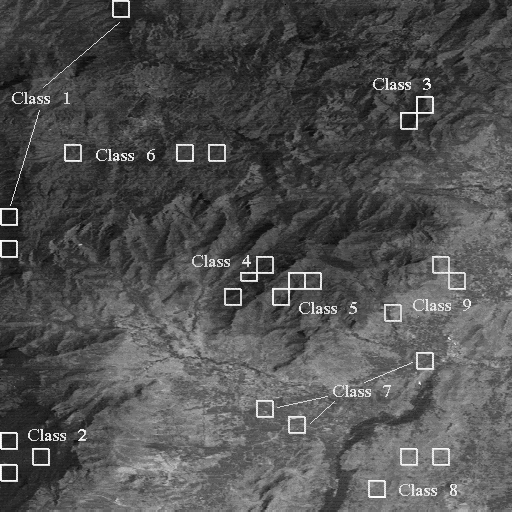 |
 |
![]()
Samples of each Class
![]()
Starting from basic images and out-image data, we try to classify the pixels
into the nine classes of vegetation of our study, in the most exactly possible
way. We perform supervised classifications,
i.e. classification from examples.
To learn how to recognize a class in an image, we have samples representative of each of the nine classes, provided by a photo-interpreter expert. A sample is a portion of the image.
All the pixels which constitute this portion of image should belong,
in theory, to the same class. But in practice, it is impossible
to obtain such pure areas, because a pixel is a merging of the spectral
responses of everything on the ground in the rectangle of 57 meters ![]() 79 meters (resolution of the spectral bands MSS of
LANDSAT corresponding to the pixel).
79 meters (resolution of the spectral bands MSS of
LANDSAT corresponding to the pixel).
In addition to spectral answers of the objects and vegetations present in this rectangle, a noise due to the sensor is added to the measure. A frame can be distinguished for example in the image of spectral band MSS6 (figure 1(c)). Samples are image areas which are very characteristic of the class to be recognized, but imperfect.
In our case, samples are small rectangular parts of the image (see the localization of the samples in the image of the figure 6. We can see that samples are not always homogeneous. It is the case for samples of classes 6 and 7, and one of the two samples of class 3. It is also true for the other classes, the other spectral bands, and out-image data.

It is known that almost all pixels of a sample belong to a same class. From these samples, we obtain
The collection of the radiometric and geographical features of each class corresponds to a training step. Radiometric features are called spectral signature. The spectral signature of a class is the histogram of grey levels of its samples.
When the features allowing to recognize the classes are known, it is then possible to perform a classification, assigning each pixel to the most resembling class. This classification is carried out for each spectral band and each out-image data.
When information of classification are collected, it remains to fuse
them to get the best final classification (see Mono-band
classification to Information fusion in
belief theory).
![]()